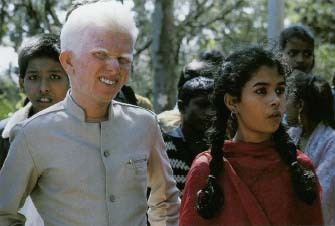Albinism

Albinism is an inherited condition in which a person lacks the usual amount of the pigment melanin, which is the substance that gives color to skin, hair, and eyes.
KEYWORDS
for searching the Internet and other reference sources
Amelanosis
Hypomelanosis
Hypopigmentation
Melanocytes
Vision
What Is Albinism?
Albinism (AL-bi-niz-im) is a disorder that occurs when a person inherits various genes * that are defective in their ability to make the pigment melanin (MEL-a-nin). Melanin is the main substance that determines a person's skin, hair, and eye color. In the United States, albinism affects approximately 1 in 17,000 people.
* genes are chemicals in the body that help determine a person's characteristics, such as hair or eye color. They are inherited from a person's parents and are contained in the chromosomes found in the cells of the body.
The outward signs of albinism vary depending on the amount of pigment a person has, and many people with albinism have skin much lighter than that of their family members. People with albinism also may have white or pale yellow hair, and light-colored eyes. Sometimes the eyes look pink because they contain no pigment to mask the red of the blood vessels in the retina * .
Albinism always affects vision to some degree. The genes that cause albinism also cause abnormal development of the nerve connections between the eyes and the brain. The retina and the iris (the colored portion of the eye) are also affected by albinism.
What Causes Albinism?
Albinism is an inherited condition that can be caused by a number of different genes.
- Type 1 albinism: This form of albinism is characterized by almost no pigmentation and is caused by a defect in a gene for an enzyme * that makes pigment.
- Type 2 albinism: People with Type 2 albinism usually have some pigmentation; this type is caused by a defect in a gene called the "P gene.
- Hermansky-Pudlak syndrome (HPS): A different defective gene causes Hermansky-Pudlak syndrome, which is a form of albinism characterized by easy bruising and bleeding and a susceptibility to lung and bowel disease. Skin, hair, and eye color vary from person to person with HPS.
- Ocular (eye) albinism: This form of albinism affects mainly the eyes; hair and skin may not look unusual.
* retina is the back inner surface of the eyeball that plays a key role in vision. This surface contains millions of light-sensitive cells that change light into nerve signals that the brain can interpret.
* enzymes (EN-zymz) are natural substances that speed up specific chemical reactions in the body.
Most people with albinism are born to parents without the condition, but both parents must carry a copy of the defective gene and both must pass on that copy to their child. Albinism is a recessive trait,

Living with Albinism
Vision problems and protecting the skin are the biggest health problems for people with albinism. The lack of pigment makes eyes and skin very sensitive to sunlight and the skin prone to burning. Vision problems vary from person to person. Some people simply need glasses to correct their vision, but others need surgery. Some people can see well enough to drive a car, whereas others are legally blind. All people with albinism need consistent and continuing eye care.
People with albinism also face social and emotional hurdles as they learn to live with being different. Emotional support from family and friends is essential to building self-esteem in a child with albinism.
* chromosomes (KRO-mo-somz) are threadlike structures inside cells on which the genes are located.
Albinism and the Eyes
Vision is always affected by albinism. Vision problems that can affect people with albinism include:
sensitivity to bright light
crossed eyes or "lazy" eyes
back-and-forth movement of the eyes
farsightedness
nearsightedness
blurry vision
Resources
National Organization for Albinism and Hypopigmentation (NOAH), 1530
Locust Street, Number 29, Philadelphia, PA 19102-4415.
Telephone 800-473-2310
http://www.albinism.org
The Hermansky-Pudlak Network, One South Road, Oyster Bay, NY 11771-1905.
Telephone 800-789-9477
http://www.medhelp.org/web/hpsn.htm